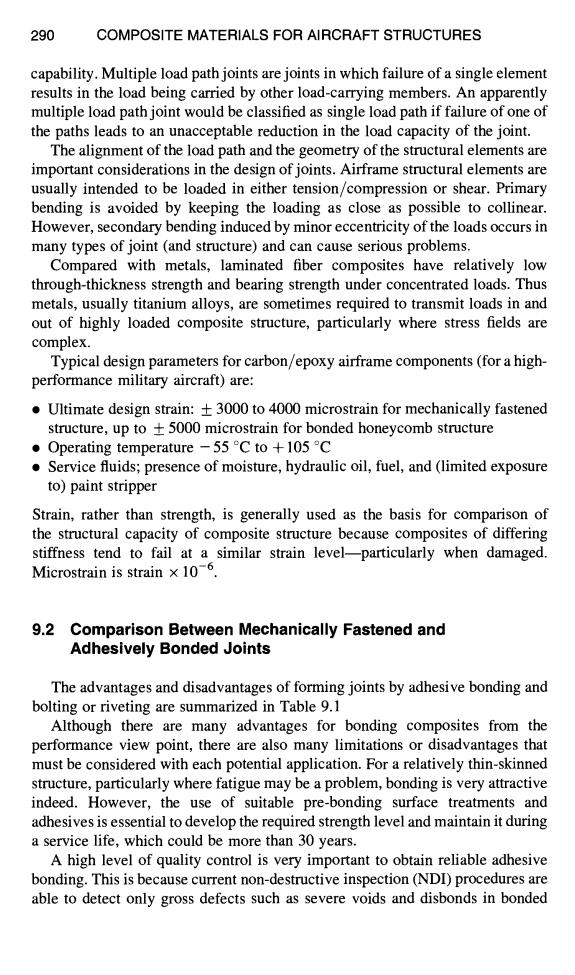正在加载图片...

290 COMPOSITE MATERIALS FOR AIRCRAFT STRUCTURES capability.Multiple load path joints are joints in which failure of a single element results in the load being carried by other load-carrying members.An apparently multiple load path joint would be classified as single load path if failure of one of the paths leads to an unacceptable reduction in the load capacity of the joint. The alignment of the load path and the geometry of the structural elements are important considerations in the design of joints.Airframe structural elements are usually intended to be loaded in either tension/compression or shear.Primary bending is avoided by keeping the loading as close as possible to collinear. However,secondary bending induced by minor eccentricity of the loads occurs in many types of joint(and structure)and can cause serious problems. Compared with metals,laminated fiber composites have relatively low through-thickness strength and bearing strength under concentrated loads.Thus metals,usually titanium alloys,are sometimes required to transmit loads in and out of highly loaded composite structure,particularly where stress fields are complex. Typical design parameters for carbon/epoxy airframe components(for a high- performance military aircraft)are: .Ultimate design strain:+3000 to 4000 microstrain for mechanically fastened structure,up to+5000 microstrain for bonded honeycomb structure Operating temperature -55 C to +105C Service fluids;presence of moisture,hydraulic oil,fuel,and (limited exposure to)paint stripper Strain,rather than strength,is generally used as the basis for comparison of the structural capacity of composite structure because composites of differing stiffness tend to fail at a similar strain level-particularly when damaged. Microstrain is strain x 10-6. 9.2 Comparison Between Mechanically Fastened and Adhesively Bonded Joints The advantages and disadvantages of forming joints by adhesive bonding and bolting or riveting are summarized in Table 9.1 Although there are many advantages for bonding composites from the performance view point,there are also many limitations or disadvantages that must be considered with each potential application.For a relatively thin-skinned structure,particularly where fatigue may be a problem,bonding is very attractive indeed.However,the use of suitable pre-bonding surface treatments and adhesives is essential to develop the required strength level and maintain it during a service life,which could be more than 30 years. A high level of quality control is very important to obtain reliable adhesive bonding.This is because current non-destructive inspection(NDI)procedures are able to detect only gross defects such as severe voids and disbonds in bonded290 COMPOSITE MATERIALS FOR AIRCRAFT STRUCTURES capability. Multiple load path joints are joints in which failure of a single element results in the load being carded by other load-carrying members. An apparently multiple load path joint would be classified as single load path if failure of one of the paths leads to an unacceptable reduction in the load capacity of the joint. The alignment of the load path and the geometry of the structural elements are important considerations in the design of joints. Airframe structural elements are usually intended to be loaded in either tension/compression or shear. Primary bending is avoided by keeping the loading as close as possible to collinear. However, secondary bending induced by minor eccentricity of the loads occurs in many types of joint (and structure) and can cause serious problems. Compared with metals, laminated fiber composites have relatively low through-thickness strength and bearing strength under concentrated loads. Thus metals, usually titanium alloys, are sometimes required to transmit loads in and out of highly loaded composite structure, particularly where stress fields are complex. Typical design parameters for carbon/epoxy airframe components (for a highperformance military aircraft) are: • Ultimate design strain: _ 3000 to 4000 microstrain for mechanically fastened structure, up to + 5000 microstrain for bonded honeycomb structure • Operating temperature - 55 °C to + 105 °C • Service fluids; presence of moisture, hydraulic oil, fuel, and (limited exposure to) paint stripper Strain, rather than strength, is generally used as the basis for comparison of the structural capacity of composite structure because composites of differing stiffness tend to fail at a similar strain level--particularly when damaged. Microstrain is strain × 10 -6. 9.2 Comparison Between Mechanically Fastened and Adhesively Bonded Joints The advantages and disadvantages of forming joints by adhesive bonding and bolting or riveting are summarized in Table 9.1 Although there are many advantages for bonding composites from the performance view point, there are also many limitations or disadvantages that must be considered with each potential application. For a relatively thin-skinned structure, particularly where fatigue may be a problem, bonding is very attractive indeed. However, the use of suitable pre-bonding surface treatments and adhesives is essential to develop the required strength level and maintain it during a service life, which could be more than 30 years. A high level of quality control is very important to obtain reliable adhesive bonding. This is because current non-destructive inspection (NDI) procedures are able to detect only gross defects such as severe voids and disbonds in bonded